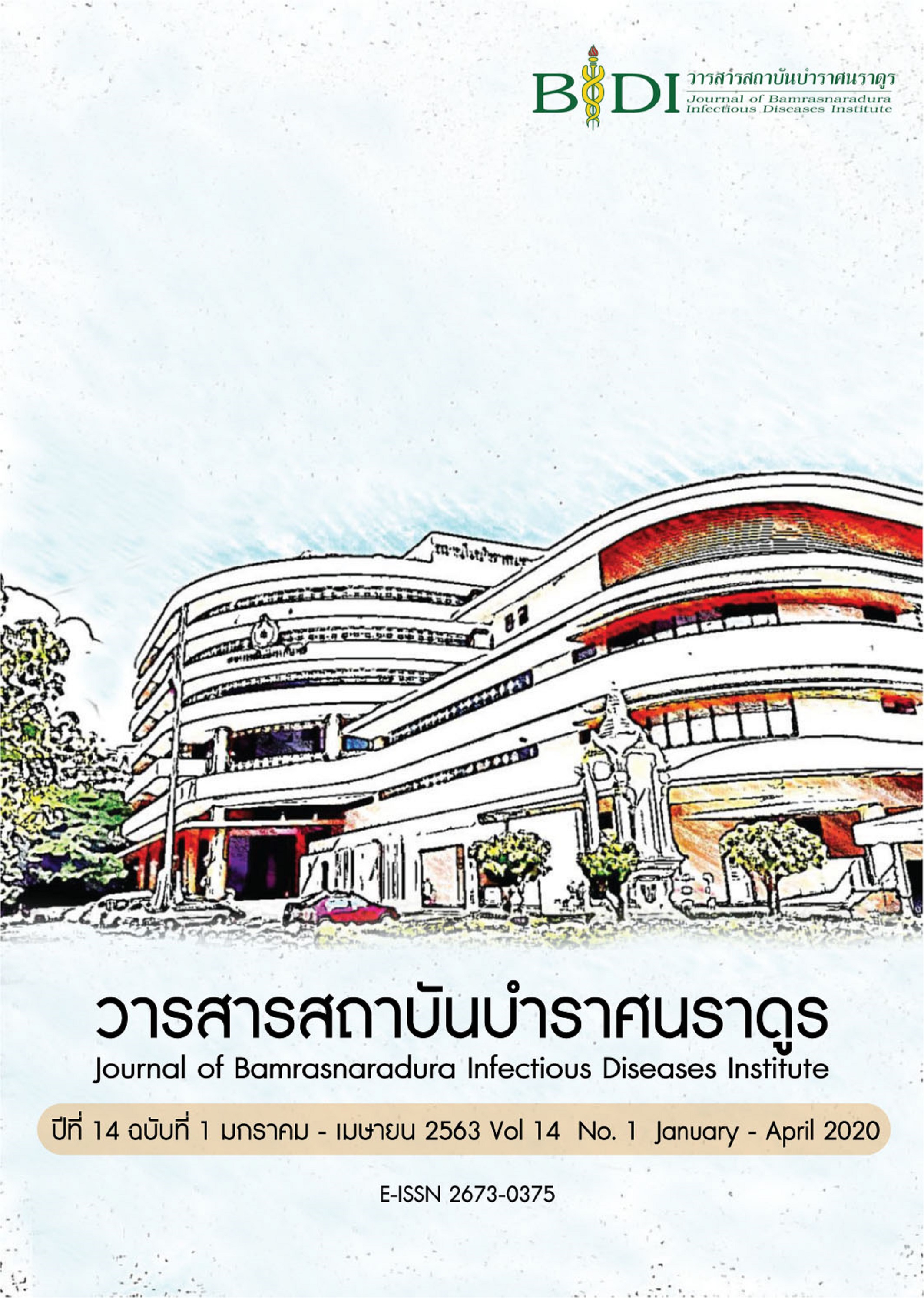คุณภาพชีวิตในการทำงานกับความผูกพันต่อองค์กรของบุคลากรสำนักโรคติดต่อนำโดยแมลง
Main Article Content
บทคัดย่อ
การวิจัยนี้มีวัตถุประสงค์เพื่อศึกษาระดับคุณภาพชีวิตในการทำงาน ระดับความผูกพันต่อองค์กร และศึกษาความสัมพันธ์ระหว่างคุณภาพชีวิตในการทำงานกับความผูกพันต่อองค์กรของบุคลากรสำนักโรคติดต่อนำโดยแมลง ประชากรคือบุคลากรสำนักโรคติดต่อนำโดยแมลง จำนวน 64 คน เครื่องมือที่ใช้ในการวิจัยคือแบบสอบถามสำรวจข้อมูล สุขภาวะองค์กร ความสุข และความผูกพันของบุคลากรในหน่วยงาน สถิติที่ใช้ในการวิจัย ได้แก่ ค่าความถี่ ร้อยละ ค่าเฉลี่ย ส่วนเบี่ยงเบนมาตรฐาน และการวิเคราะห์สหสัมพันธ์แบบเพียร์สัน (Pearson’s product moment correlation coefficient) ผลการศึกษาพบว่า ในภาพรวม บุคลากรมีระดับคุณภาพชีวิตการทำงานอยู่ในระดับปานกลาง มีระดับความผูกพันต่อองค์กรอยู่ในระดับมาก และพบว่าคุณภาพชีวิตการทำงานมีความสัมพันธ์เชิงบวกกับความผูกพันต่อองค์กรอย่างมีนัยสำคัญทางสถิติที่ระดับ < 0.001 โดยพบว่า มีความสัมพันธ์กันในระดับสูงมาก (r = 0.774) ยกเว้นด้านการพัฒนาศักยภาพและการใช้ขีดความสามารถของบุคคลไม่พบความสัมพันธ์กับความผูกพันต่อองค์กร
ผลการวิจัยนี้ชี้ให้เห็นว่า คุณภาพชีวิตในการทำงานมีความสัมพันธ์กับความผูกพันต่อองค์กร ดังนั้นจึงควรปรับปรุงคุณภาพชีวิตด้านต่างๆที่มีระดับน้อย และปานกลางให้อยู่ในระดับมาก เพื่อให้บุคลากรเกิดความผูกพันต่อองค์กรมากขึ้น เช่น ด้านค่าตอบแทนที่เพียงพอและยุติธรรม ควรให้บุคลากรได้วางแผนการบริหารผลการปฏิบัติงานร่วมกับผู้บังคับบัญชาก่อนการประเมินการปรับขึ้นเงินเดือน สื่อสารให้บุคลากรทราบถึงการเติบโตในสายงาน เพื่อให้บุคลากรมั่นใจที่จะร่วมงานกับองค์กร
Article Details
เอกสารอ้างอิง
Kittisuksathit S, Tangchonlatip K, Jaratsist S, Saiprasert C, Boonyateerana P, Aree W. Happinometer: the happiness self-assessment. 1st ed. Nakornpathom: Institute for Population and Social Research, Mahidol University; 2012. (in Thai)
Walton RE. Quality of working life: What is it? Sloan Management Review 1973; 15(1): 11-2.
Steers RM, Lyman WP. Motivation and work behavior. 3rd ed. New York: McGraw-Hill; 1983.
Puagsopa S. The study of the relationship between personal factors and the happiness at work a case study of the faculty members and the staffs of The University of the Thai Chamber of Commerce [dissertation]. Bankok: University of the Thai Chamber of Commerce; 2013. (in Thai)
Romkhuen C. Guidelines for creating happy organizations for pattaya city [dissertation]. Chon Buri: Burapha University; 2016. (in Thai)
Palasingha J. Happiness index of Burapha University community. Journal of Humanities and Social Sciences 2016; 24(45): 65-89. (in Thai)
Bamrungsoonthorn P. Factors associated with happiness level in health personnel of contracting unit for primary care in Wangchan District, Rayong Province. Journal Korat 2018; 4(1): 22-35. (in Thai)
Katesing W. Handbook of research and practice. 3rd ed. Bangkok: Thai Watana Panich; 1998. (in Thai)
Srisa-ard B, Nilkaew B. Population reference when using scale tools estimate the value with a sample. Journal of Educational Measurement, Mahasarakham University 2014; 3(1): 23-5. (in Thai)
Piya P. The relationship between quality of working life and organizational commitment of supporting staff at University of Phayao [dissertation]. Phayao: University of Phayao; 2013. (in Thai)
Silprakob R. The relationship between the quality of work life and the organizational commitment of Thammasat University Hospital employees [termatic paper]. Pathumthani: Valaya Alongkorn Rajabhat University under the Royal Patronage; 2015. (in Thai)
Sroisudsawas S. Quality of work life and organizational commitment of Northern Rajabhat University employees [dissertation]. Uttaradit: Uttaradit Rajabhat University; 2011.(in Thai)
Ruthirunkorn P. Relationships between quality of working life and employee engagement of the National Health Security Office, headquarter [dissertation]. Nakornpathom: Silpakorn University; 2011.(in Thai)
Wonganutrohd P. Personnel management psychology. 5th ed. Bangkok: Bangkok Enhanced Media Center; 2010. (in Thai)


